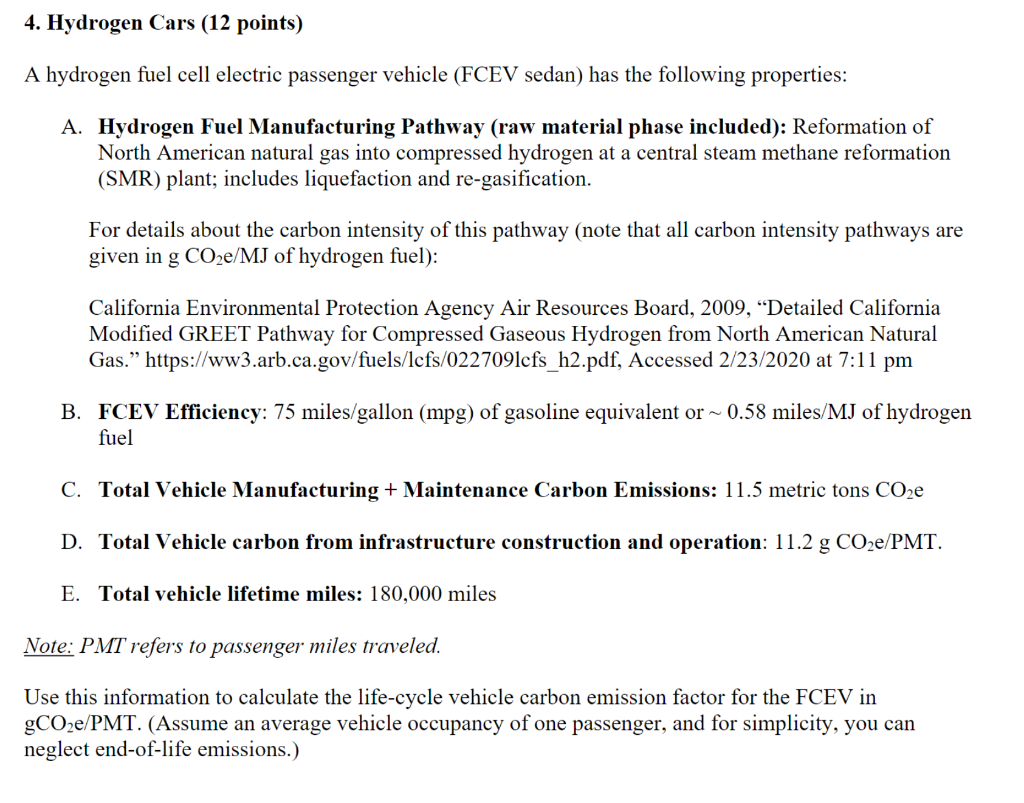
4. Hydrogen Cars (12 points) A hydrogen fuel cell electric passenger vehicle (FCEV sedan) has the following properties: A. Hydrogen Fuel Manufacturing Pathway (raw material phase included): Reformation of North American natural gas into compressed hydrogen at a central steam methane reformation (SMR) plant; includes liquefaction and re-gasification. For details about the carbon intensity of this pathway (note that all carbon intensity pathways are given in g CO2/MJ of hydrogen fuel): California Environmental Protection Agency Air Resources Board, 2009, Detailed California Modified GREET Pathway for Compressed Gaseous Hydrogen from North American Natural Gas. https://ww3.arb.ca.gov/fuels/lefs/0227091cfs_h2.pdf, Accessed 2/23/2020 at 7:11 pm B. FCEV Efficiency: 75 miles/gallon (mpg) of gasoline equivalent or ~ 0.58 miles/MJ of hydrogen fuel C. Total Vehicle Manufacturing + Maintenance Carbon Emissions: 11.5 metric tons CO2e D. Total Vehicle carbon from infrastructure construction and operation: 11.2 g CO2e/PMT. E. Total vehicle lifetime miles: 180,000 miles Note: PMT refers to passenger miles traveled. Use this information to calculate the life-cycle vehicle carbon emission factor for the FCEV in gCO2e/PMT. (Assume an average vehicle occupancy of one passenger, and for simplicity, you can neglect end-of-life emissions.) 4. Hydrogen Cars (12 points) A hydrogen fuel cell electric passenger vehicle (FCEV sedan) has the following properties: A. Hydrogen Fuel Manufacturing Pathway (raw material phase included): Reformation of North American natural gas into compressed hydrogen at a central steam methane reformation (SMR) plant; includes liquefaction and re-gasification. For details about the carbon intensity of this pathway (note that all carbon intensity pathways are given in g CO2/MJ of hydrogen fuel): California Environmental Protection Agency Air Resources Board, 2009, Detailed California Modified GREET Pathway for Compressed Gaseous Hydrogen from North American Natural Gas. https://ww3.arb.ca.gov/fuels/lefs/0227091cfs_h2.pdf, Accessed 2/23/2020 at 7:11 pm B. FCEV Efficiency: 75 miles/gallon (mpg) of gasoline equivalent or ~ 0.58 miles/MJ of hydrogen fuel C. Total Vehicle Manufacturing + Maintenance Carbon Emissions: 11.5 metric tons CO2e D. Total Vehicle carbon from infrastructure construction and operation: 11.2 g CO2e/PMT. E. Total vehicle lifetime miles: 180,000 miles Note: PMT refers to passenger miles traveled. Use this information to calculate the life-cycle vehicle carbon emission factor for the FCEV in gCO2e/PMT. (Assume an average vehicle occupancy of one passenger, and for simplicity, you can neglect end-of-life emissions.)







